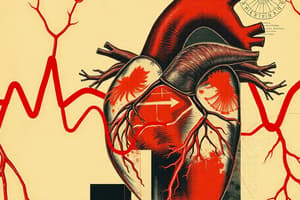Podcast
Questions and Answers
What is the primary function of the coronary arteries?
What is the primary function of the coronary arteries?
- They hold the blood within the body.
- They regulate the heart's electrical impulses.
- They provide the heart with oxygen and nutrients. (correct)
- They carry blood to the lungs.
Which of the following correctly describes the flow of blood from the heart to the body?
Which of the following correctly describes the flow of blood from the heart to the body?
- Blood flows from the aorta to the pulmonary artery.
- Blood flows from the vena cava to the atria.
- Blood flows from the right atrium to the left ventricle.
- Blood flows from the left ventricle to the aorta. (correct)
What role does the pacemaker in the heart play?
What role does the pacemaker in the heart play?
- It holds blood until the heart is ready to pump.
- It prevents blood from flowing backward.
- It generates electrical impulses to regulate heartbeats. (correct)
- It carries blood away from the heart.
Which statement is true about arteries?
Which statement is true about arteries?
What happens when the atria of the heart contract?
What happens when the atria of the heart contract?
What is the primary advantage of a double circulatory system?
What is the primary advantage of a double circulatory system?
Which vessel carries deoxygenated blood from the heart to the lungs?
Which vessel carries deoxygenated blood from the heart to the lungs?
What is the role of the pacemaker in the heart?
What is the role of the pacemaker in the heart?
Which of the following statements about heart valves is correct?
Which of the following statements about heart valves is correct?
What is the typical resting heart rate in beats per minute?
What is the typical resting heart rate in beats per minute?
What is a primary role of the alveolus in the respiratory system?
What is a primary role of the alveolus in the respiratory system?
How does the presence of capillaries affect gas diffusion in the alveoli?
How does the presence of capillaries affect gas diffusion in the alveoli?
Which of the following statements about the breathing rate is correct?
Which of the following statements about the breathing rate is correct?
What effect would damaged alveoli have on gas exchange?
What effect would damaged alveoli have on gas exchange?
When carbon dioxide is transported in the blood, how is it primarily found?
When carbon dioxide is transported in the blood, how is it primarily found?
What is the primary function of capillaries in the circulatory system?
What is the primary function of capillaries in the circulatory system?
Which characteristic of arteries contributes most to maintaining high blood pressure?
Which characteristic of arteries contributes most to maintaining high blood pressure?
Which of the following substances is NOT typically exchanged in capillaries?
Which of the following substances is NOT typically exchanged in capillaries?
What is the main role of veins in the circulatory system?
What is the main role of veins in the circulatory system?
What is the formula for calculating the rate of blood flow given the volume and time?
What is the formula for calculating the rate of blood flow given the volume and time?
What is the primary function of red blood cells?
What is the primary function of red blood cells?
Which component of blood is responsible for the clotting process?
Which component of blood is responsible for the clotting process?
What is the main component that makes plasma watery and helps in the flow of blood?
What is the main component that makes plasma watery and helps in the flow of blood?
What significant feature do white blood cells lack that red blood cells possess?
What significant feature do white blood cells lack that red blood cells possess?
Haemoglobin is primarily involved in binding to which type of molecule?
Haemoglobin is primarily involved in binding to which type of molecule?
Flashcards are hidden until you start studying
Study Notes
Circulatory System Overview
- Composed of blood, blood vessels, and heart.
- Transports oxygen, nutrients, and waste products throughout the body.
- Features a double circulatory system with two loops: one to the lungs and one to the rest of the body.
- Double circulation allows for more efficient oxygenation and nutrient delivery, reducing pressure increases in the heart.
Heart Structure and Function
- Consists of four chambers: left atrium, left ventricle, right atrium, right ventricle.
- Right side pumps deoxygenated blood to the lungs via the pulmonary artery.
- Left side receives oxygenated blood from the lungs through the pulmonary vein and distributes it to the body via the aorta.
- Left ventricle wall is thicker to pump blood at higher pressure throughout the body.
- Valves (tricuspid and bicuspid) prevent back-flow of blood; semilunar valves exist between ventricles and arteries.
Blood Flow Pathway
- Blood enters the heart via vena cava (deoxygenated) and pulmonary vein (oxygenated).
- Atria fill with blood and contract to push blood into ventricles.
- Ventricles contract to send blood to the lungs (pulmonary artery) and body (aorta).
Heart Rate and Pacemaker Mechanism
- Normal resting heart rate averages around 70 beats per minute.
- Heart rhythm controlled by a natural pacemaker in the right atrium, which generates electrical impulses to coordinate contractions.
- Artificial pacemakers can regulate heart rhythm in cases of irregular beats.
Blood Vessels
- Arteries: Carry oxygen-rich blood away from the heart, possess thick elastic walls to withstand high pressure, and have a narrow lumen.
- Veins: Return deoxygenated blood to the heart, feature thinner walls with larger lumens than arteries, and contain valves to prevent back-flow.
- Capillaries: Microscopic vessels where gas exchange occurs; walls are one cell thick to facilitate diffusion of oxygen, carbon dioxide, nutrients, and waste.
Respiratory System and Alveoli
- Alveoli are small air sacs in the lungs facilitating gas exchange; traits include a large surface area, moisture for gas dissolution, and a single-cell thick wall.
- Oxygen diffuses from alveoli into blood; carbon dioxide diffuses from blood into alveoli.
Blood Composition
- Red Blood Cells: Transport oxygen due to hemoglobin; lack a nucleus to maximize space for oxygen transport.
- White Blood Cells: Key components of the immune system; producing antibodies and engaging in phagocytosis to eliminate pathogens.
- Plasma: Liquid component of blood carrying nutrients, hormones, and waste products; constitutes about half of blood volume.
Key Terms
- Diffusion: Process allowing oxygen to move from alveoli into blood and carbon dioxide from blood into alveoli.
- Hemoglobin: Protein in red blood cells essential for oxygen transport; binds oxygen for delivery to tissues.
- Phagocytosis: Mechanism by which white blood cells engulf and destroy pathogens.
Calculation Examples
- Breathing rate can be calculated by the number of breaths taken divided by the time measured in minutes.
- Example: 14 breaths per minute equates to 7 breaths in 30 seconds.
- Heart rate calculation involves determining volume of blood flow over a specific period of time.
Studying That Suits You
Use AI to generate personalized quizzes and flashcards to suit your learning preferences.





